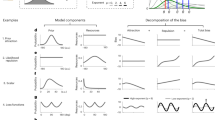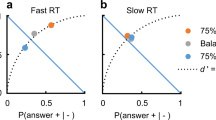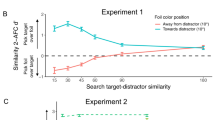Abstract
Although attention usually enhances perceptual sensitivity, we found that it can also lead to relatively conservative detection biases and lower visibility ratings in discrimination tasks. These results are explained by a model in which attention reduces the trial-by-trial variability of the perceptual signal, and we determined how this model led to the observed behavior. These findings may partially reflect our impression of 'seeing' the whole visual scene despite our limited processing capacity outside of the focus of attention.
This is a preview of subscription content, access via your institution
Access options
Subscribe to this journal
Receive 12 print issues and online access
$209.00 per year
only $17.42 per issue
Buy this article
- Purchase on Springer Link
- Instant access to full article PDF
Prices may be subject to local taxes which are calculated during checkout


Similar content being viewed by others
References
Carrasco, M. Vision Res. 51, 1484–1525 (2011).
Kim, C.Y. & Blake, R. Trends Cogn. Sci. 9, 381–388 (2005).
Azzopardi, P. & Cowey, A. Nature 361, 719–721 (1993).
Gordon, J. & Abramov, I. J. Opt. Soc. Am. 67, 202–207 (1977).
Green, D.M. & Swets, J.A. Signal Detection Theory and Psychophysics (John Wiley & Sons, New York, 1966).
Lu, Z.L. & Dosher, B.A. Vision Res. 38, 1183–1198 (1998).
Gorea, A. & Sagi, D. Proc. Natl. Acad. Sci. USA 97, 12380–12384 (2000).
Lau, H. & Rosenthal, D. Trends Cogn. Sci. 15, 365–373 (2011).
McDonnell, M.D. & Abbott, D. PLOS Comput. Biol. 5, e1000348 (2009).
Dosher, B.A. & Lu, Z.L. Psychol. Sci. 11, 139–146 (2000).
Cohen, M.R. & Maunsell, J.H. Nat. Neurosci. 12, 1594–1600 (2009).
Mitchell, J.F., Sundberg, K.A. & Reynolds, J.H. Neuron 63, 879–888 (2009).
Maier, A. et al. Nat. Neurosci. 11, 1193–1200 (2008).
Desimone, R. & Duncan, J. Annu. Rev. Neurosci. 18, 193–222 (1995).
Reynolds, J.H. & Heeger, D.J. Neuron 61, 168–185 (2009).
Acknowledgements
H.L. received funding from the Human Frontiers Science Project (Short-Term Fellowship) and the Templeton Foundation (grant number 21569).
Author information
Authors and Affiliations
Contributions
D.R. conducted the experiments, analyzed the data and wrote the manuscript. B.M. performed the model fitting and comparison. T.G. and E.H. helped with data collection and conducted some of the control studies. F.P.d.L. conducted the eye-tracking control study. H.L. conceived the experiments, supervised the project, analyzed the data and wrote the paper.
Corresponding authors
Ethics declarations
Competing interests
The authors declare no competing financial interests.
Supplementary information
Supplementary Text and Figures
Supplementary Figures 1–8 and Supplementary Methods (PDF 1621 kb)
Rights and permissions
About this article
Cite this article
Rahnev, D., Maniscalco, B., Graves, T. et al. Attention induces conservative subjective biases in visual perception. Nat Neurosci 14, 1513–1515 (2011). https://doi.org/10.1038/nn.2948
Received:
Accepted:
Published:
Issue Date:
DOI: https://doi.org/10.1038/nn.2948
This article is cited by
-
Studying the neural representations of uncertainty
Nature Neuroscience (2023)
-
Sources of confidence in value-based choice
Nature Communications (2021)
-
Increased face detection responses on the mooney faces test in people at clinical high risk for psychosis
npj Schizophrenia (2021)
-
Overlapping and unique neural circuits are activated during perceptual decision making and confidence
Scientific Reports (2020)
-
The suboptimality of perceptual decision making with multiple alternatives
Nature Communications (2020)



